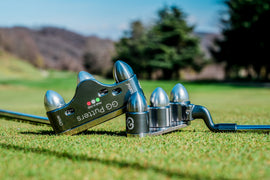In the world of golf, understanding the various factors that affect your game is crucial. One such important factor is spin loft. The relationship between the angle of attack and dynamic loft, known as spin loft, plays a significant role in determining the spin rate and control of your shots. In this article, we will delve into the concept of spin loft, explore its significance in golf, and provide you with valuable insights on how to optimise your spin loft for better performance. So, let's dive into the world of spin-driven golf!
What is Spin Loft?
FlightScope defines Spin Loft as “The contribution to ball spin as a result of the effective loft on the club face presented to the ball during impact, which is approximately defined by the difference between the 3D angle of attack and 3D dynamic loft of the club at impact.”
So what does that mean? Spin loft refers to the relationship between the angle of attack and dynamic loft at impact. It essentially determines the amount of spin imparted on the golf ball when struck by the clubface. The spin loft angle is the difference between the angle of attack and dynamic loft, and it greatly influences the spin rate and trajectory of your shots.
The spin loft angle directly affects the spin rate and control of your shots. Here's a breakdown of its impact:
Spin Rate:
- A lower spin loft tends to produce lower spin rates, resulting in shots that have less backspin and vice versa. High spin loft creates higher spin rate based on centre contact and no interference between club face and golf ball. However, shots with a spin loft of over 45° have a tendency to see the spin rate drop.
Shot Trajectory:
- Golfers are looking to lower their spin loft angle to maximise distance with the driver
- A lower spin loft angle tends to generate a lower spin and would increase roll upon landing and penetrate into a headwind
What is a good spin loft?
On the PGA & LPGA tour, you are looking at around 12 degrees of spin loft with the driver and 25 degrees with a 6 iron. Some players, such as Rickie Fowler, are lower at just 11 degrees. Amateur golfers will be higher with a spin loft of 15-30 degrees with the driver. This is where having a launch monitor can really progress your game. If you can see your spin loft reducing, then you know you are closing the gap between you and the pros. But just how can you go about making that improvement?
How to improve your spin loft
To enhance your performance and optimise your spin loft, consider the following tips:
Angle of Attack Adjustment
- Experiment with adjusting your angle of attack to find the optimal balance.
- For shots requiring more backspin, try to achieve a steeper angle of attack.
Dynamic Loft Modification
- Explore different clubface loft configurations to find the optimal dynamic loft.
- Adjusting the loft can help fine-tune the spin loft and achieve the desired spin characteristics.
Practice and Feedback
- Regularly practise and monitor your shots to gain a better understanding of how different angles of attack and dynamic lofts influence your spin loft.
- Seek feedback from professionals or use launch monitors to analyse your shots and make informed adjustments.
Equipment Considerations
- Consult with a professional club fitter to ensure your equipment, including shaft flex, length, and clubhead design, suits your swing and spin loft goals.
By implementing these strategies and developing a better understanding of spin loft, you can optimise your shots for improved control, distance, and accuracy on the golf course.
If you’re looking for a launch monitor to track spin loft, look no further than the FlightScope X3 for which we are the exclusive UK & Ireland distributor.



